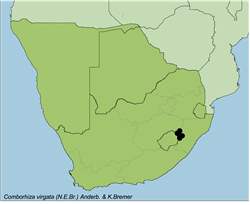Names and synonyms
Comborhiza virgata (N.E.Br.) Anderb. & K.Bremer= Nestlera virgata N. E. Brown = Relhania tuberosa Bremer
Type
Evans 50, on the Drakensberg, 1830-2130 m (K, holo.; Z, iso.).
Derivation of names
combos = knot, tuber; rhiza = root - refering to the stunted basal parts of the plantsvirgata = twiggy
Diagnostic characters
Capitula borne on short brachyblasts along the upper branches Stems and leaves densely covered in multicellular glands
Description
An unbranched or moderately branched shrublet, up to c. 0.5 m high, stems and leaves covered in dense multicellular glands. Stems densely leafy above, arising from subterranean, thick, woody tubers, ascending-erect, laxly puberulous and glandular-hispid, leafy, with lateral brachyblasts with crowded leaves, becoming glabrous and nude and marked with scars after leaves and brachyblasts. Leaves alternate on stems, crowded in brachyblasts with subtending leaves much longer and flatter than those on brachyblasts, spreading, flat or somewhat canaliculate, midribbed more prominent on subtending leaves, linear or narrowly elliptic-oblong, 2-20(-25) x 0.5-2(-3) mm, densely glandular-hispid, acute to acuminate. Capitula solitary, sessile, terminal and lateral on brachyblast tips. Involucre 3-12 mm wide, cup-shaped-bell-shaped,. Involucral bracts 40-65, outer ovate, inner gradually longer and oblong with a spreading, brownish apical limb, innermost narrowly obovate, also with a spreading, brownish apical limb, entire or becoming laciniate, 9-12 x 1.8-2.1 mm wide, dorsally sparsely gland-dotted, acute to acuminate. Receptacle flat-convex, epaleate, but often shortly squamose. Ray florets 20-25, tube 2.5-3.8 mm long, glandular; lamina narrowly elliptic-oblong, 6-7 x 1.2-1.9 mm, yellow and sometimes dorsally with a brownish purple stripe, 4-veined; cypselas triquetrous, narrowly elliptic-oblong, 3.1-4 x 0.5-0.7 mm, shortly hispid with erect hairs; pappus as in disc florets. Disc florets 25-40, perfect; 5.2-5.8 x 0.6-0.8 mm; tube � glandular; cypselas somewhat triquetrous, narrowly elliptic-oblong, 3.1-4 x 0.4-0.6 mm, glabrous; pappus crownlike, of connate scales, up to 0.8 mm long.
Flowering time
Mainly in June and July.
Distribution
Grows in open grassland on the slopes of the northern Drakensberg (Cathedral Peak; Champagne Castle; Umlambonja; Ndedema Valley; Mount Weni; Giant's Castle; Lower Injasuti Area; Tabamhlope; Monks Cowl).Known from about 11 collections.
Habitat
Grassland, in valleys amongst rocks or on steep river or stream banks.
Notes
This is a characteristic species with glandular-hispid leaves in fascicules on brachyblasts. It has a subterranean, thick, woody tuber, from which new shoots can develop after veld fires.
References
ANDERBERG, A.A. & BREMER, K. 1991. Parsimony analysis and cladistic reclassification of the Relhania generic group (Asteraceae - Gnaphalieae). Annals of the Missouri Botanical Garden 78: 1061-1072.BROWN, N.E. 1895. Decades Kewensis XIII. Kew Bulletin 98: 25.GLEN, H.F. 2004. SAPPI, What's in a Name? The Meanings of the Botanical Names of Trees. Jacana.HILLIARD, O.M. 1977. Compositae in Natal. University of Natal Press.
